| Issue 6 |
The speaker reminded us that some 20 or 30 years ago railways were thought to be an old technology that had had its day. However their environmental advantages are now appreciated, and their ability to reduce congestion by moving large numbers of people in and out of cities is vital for the economy. And importantly, in many parts of the world, high-speed trains running on dedicated tracks are bringing high standards of speed, safety, comfort and punctuality to inter-city ground transport.
The remarkably low rolling resistance of steel wheels on steel rails, about 0.1% of the weight (as opposed to 1% for car tyres on a road) has always been recognised. But the price of very low rolling resistance is extremely high contact stresses, so that each wheel pass is irreversible in elastic terms, and fatigue damage accumulates. Sliding friction, needed for traction and braking, is about 30% of the weight for steel wheels on dry rails, but falls to 10% in the wet, or to only 5% in the presence of fallen leaves. These figures, much lower than for road vehicles, can be a substantial operational restraint.
At any useful speed, the rolling resistance to a train's motion is completely outweighed by its air resistance, but here again, the railway has an advantage, the "convoy effect". The air resistance of a train of coaches is much less than the sum of resistances of these coaches on their own.
The greater safety of railways is in large part due to the "signal block" system, by which the line is divided into blocks, of a length determined by the stopping distance of the fastest train. A train may not enter any block until the train in front has left it. If the maximum permitted speed is V, then d, the length of the block, will be proportional to V2. If all trains are in fact travelling at this speed, each will take a time d/V to traverse the block, and the train frequency can be up to V/d, which is proportional to V-1. Fast trains have to run at longer intervals. This is perhaps not unreasonable, but if a much slower train is using the line too, its block transit time will be much longer, and the line capacity will be much reduced. Mixing different types of traffic on the same track has a very detrimental effect on a railway's performance. High-speed trains should have their own reserved tracks. A combination of an electronic data link to the train with display of full information and instructions to the driver, as used on Japanese high-speed lines, can then improve both capacity and punctuality.
Traditionally, the avoidance of collisions has relied not only on the block system, but also on the driver seeing and obeying the signals. Apparently on average each driver commits one SPAD (signal passed at danger) sometime during his career. This may or may not be lethal, depending on the circumstances, but is clearly undesirable. There have long been automatic systems for warning the driver of the state of the next signal, or if he has just passed one at red; and at least one of these systems used to apply the brakes in the latter case. But a new Train Protection and Warning System is now being installed on all lines in the UK, which will apply the brakes automatically when necessary.
In fact, passenger deaths due to railway accidents in Britain have totalled only about 2000 in the whole of railway history so far, whereas road deaths are of order 3000 per annum. Figure 1 shows rail deaths per annum since 1840. In the last hundred years there have been occasional years with major disasters, but the general trend is clearly downwards. Figure 2 attempts a comparison with other modes of transport by showing passenger fatality rates per billion passenger kilometres since 1982. It is not clear whether this is the appropriate measure for comparison. For example, Table 1 implies that on this basis walking (or cycling) is 380 times more dangerous than flying. But there are not many journeys for which these are genuine alternatives. Perhaps expressing fatalities as per passenger hour, or per passenger journey, might give a more realistic comparison.
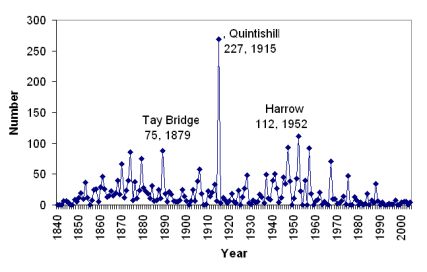
|
| Figure 1: Rail passengers killed by year |
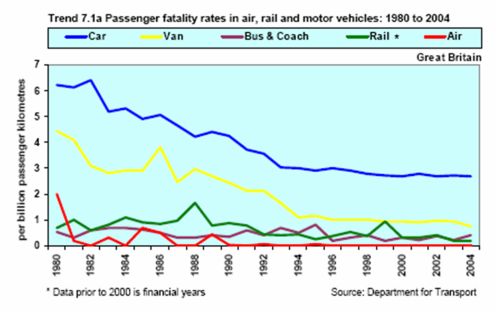
|
|
Figure 2: Passenger fatality rates in air, rail and motor vehicles 1980 to
2004 (Source: Department for Transport. Data prior to 2000 is financial years) |
| ||||||||||||||
| Table 1 (data from DoT, Transport Trends 2005, #DoT, National Travel Survey 2005) |
The more perfect is the geometry of the railway track, the smoother will be the ride, which is clearly an attraction to the passengers. But fatigue damage to rails and wheels will also be reduced. High-speed trains require a more perfect track on both these grounds, but achieving that perfection, and maintaining it, can be very expensive. Reducing the weight of rolling-stock, and particularly of its unsprung mass (the bogies, wheels and axles) will reduce the fatigue damage caused by minor imperfections in the rail geometry, and hence the cost of maintenance. In the Japanese Shinkansen high-speed trains, the change from Series 100 to Series 300 went with a speed rise from 190 to 220 kph, but since both total and unsprung mass were reduced by some 25%, the rail maintenance cost actually went down by some 10%. The train mass per seat of the latest versions of this train is now down to about 550 kg. British trains are much heavier. For instance the Virgin Voyager and Pendolino are twice as heavy, at about 1100 kg per passenger seat. Table 2 shows mass/passenger for various "vehicles" (some of them obviously very approximate).
| ||||||||||||||||
| Table 2: Vehicle masses per passenger |
But it is interesting that the jumbo jet comes out as heavier than Japanese high-speed trains, but lighter than British ones. Part, at least, of the explanation is that from the way British Rail was privatised, there has been no economic incentive to design, or purchase, lighter rolling-stock. The trains are owned by one set of companies, and operated by another set, on track owned by Network Rail, who originally (but no longer) employed yet another set of companies to maintain it.
Professor Smith went on to illustrate the disastrous consequences that could follow from ignoring fatigue damage. Rails wear out of shape, and develop cracks, as a result of rolling stock passing over them. Cracks propagate initially at a shallow angle of about 15° to the horizontal, to a depth of about 5-15 mm, but then turn down to a much steeper angle of about 70°, as shown in Figure 3. Rails therefore need to be reground periodically both to remove the cracked layer and to restore the proper profile on the upper surface (Figure 4). Railtrack and its contractors had neglected to do this, which resulted in a high-speed derailment at Hatfield on the main NE line in October 2000, when a heavily cracked rail broke into 300 pieces (Figure 5). In terms of its organisational and economic implications, this was perhaps the most traumatic and expensive accident in UK railway history.
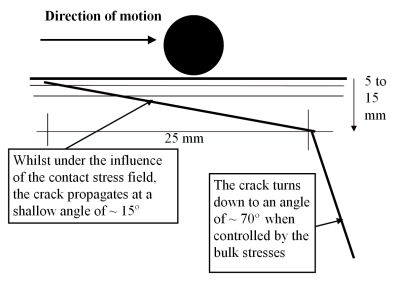
|
| Figure 3: Crack propagation in rails |
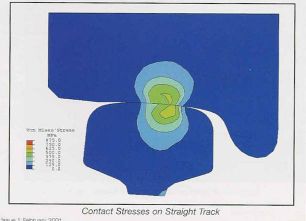 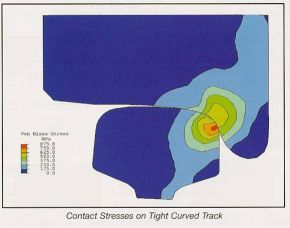
|
|
Figure 4: Top: Position of contact in normal running Bottom: Movement to gauge corner produces higher contact stresses |
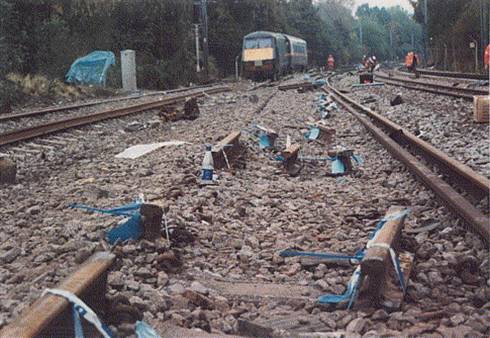
|
| Figure 5: Broken rail at Hatfield |
In a similar German counterpart, an intercity express suffered a high-speed derailment between Hanover and Hamburg in June 1998, resulting in 101 deaths. Here it was a tyre that broke, again through improper maintenance. The tyre was of a special type, separated from the hub by rubber pads to reduce the transmission of noise and vibration. So it was unsupported by the hub as far as bending stresses were concerned. Its radial thickness had been 64 mm at the start of its life. It had been re-profiled four times (without replacement), so reducing its thickness to 35 mm and trebling the stress in it. It then, after running some 1.8 million km in total, suffered a fatigue failure and came off (Figures 6 and 7).
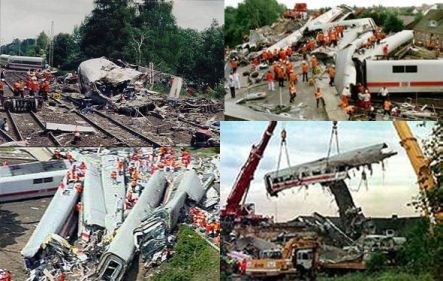
|
| Figure 6: Aftermath of 1998 German crash |
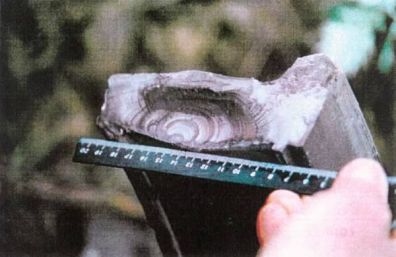
|
| Figure 7: The failed tyre that caused the derailment |
Interestingly, only a fortnight later than this German crash, an InterCity 225 derailed here at Sandy (Bedfordshire) due to a broken wheel. Again it was a fatigue failure, this time starting at a drilled balance weight hole in the wheel disc. But this time there were no fatalities, perhaps in part because considerable work had been done, following the Clapham crash in December 1988, to make rolling stock better capable of protecting the occupants in the event of a crash. Coaches are now strong monocoque structures, in which the ends can absorb about 2 MJ of energy by crushing, while the centre section remains intact. Furthermore the couplings are designed to stop coaches over-riding each other. But the passengers inside are still unrestrained and free to cannon into each other!
Table 3 shows the amount of CO2 emitted per passenger journey using different transport modes on three routes between London and other cities in the UK. Rail is far better than air or car travel between London and Manchester or Edinburgh, which are electrified routes, but for the diesel-operated route between London and Bristol, the advantage is somewhat reduced, though it is still a factor of two or so. Coach travel, it may be noted, is even better than rail (though somewhat slower). The advantage of electrification is not only in the cleaner way in which at least some of the energy is generated, but also in the possibility of recovering quite a lot of it through regenerative braking.
| ||||||||||||||||||||||||||||
| Table 3: CO2 emission, kg/passenger journey | ||||||||||||||||||||||||||||
Only about 30% of British lines are electrified, about the lowest proportion in Europe. Italy, the Netherlands and Sweden all have well over 60%, no doubt having been impelled to that position years ago by the shortage of indigenous fossil fuels. The current anxiety over climate change should be pushing this country in a similar direction.
The Japanese are now on their fifth generation of truly high-speed trains, running precisely to time on dedicated lines. We on the other hand still have only one, the Channel Tunnel Line, which is capable of 300 kph. If we study where the best prospects for such lines can be found, it appears to be to link London to Birmingham, Manchester, Liverpool and Leeds. Reliable high-speed trains on these routes could compete very favourably with air and road transport, but would have less advantage on the longer routes to Scotland, where the demand is less and air travel is well established.
Dedicated lines are essential, since mixed traffic, if permitted, can cause substantial delays, for instance as occur on the main line from London to the NE, because of the single track in each direction on the Welwyn viaduct.
The final subject was electromagnetically levitated trains with linear motor drive, which were very topical on the day of the lecture, since a German version had had a bad crash on its experimental track the day before. It had collided at high speed with an engineer's vehicle which had unaccountably been left parked on the elevated track, resulting in 21 deaths. But it was not clear that this disaster cast any doubt on the feasibility or safety of such trains in normal operation.
For his final slide, Rod Smith showed us a cautionary quotation from Aldo Moro, late Prime Minister of Italy, that:
"There are two types of madmen: those who believe they are Napoleon and those who think they can sort out the railways."
| << Previous article | Contents | Next article >> |
| SOUE News Home |
Copyright © 2007 Society of Oxford University Engineers |
SOUE Home |